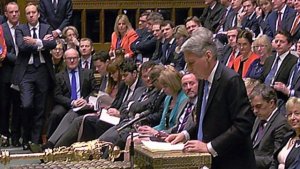- Residential property

Longer Reads
The CGT consequences of buying a ‘space in a tower’
William Hancock clarifies the law around Private Residence Relief.
5 minute read
Published 27 November 2019
Key information
- Specialisms
- Private Wealth
- Services
- Residential property
There is nothing new in buying property off-plan.
The phrase “contract for an off-plan purchase” entered the statute book in 2015 where it means “a contract for the acquisition of land consisting of, or including, a building or part of a building that is to be constructed or adapted for use as a dwelling” (Finance Act 2015 Sch. 7(1) para 36).
It has become, however, increasingly popular in recent times, it being harder for property developers to raise capital from the banks since the credit crunch of 2008.
These contracts represent an attractive proposition to buyers because of the substantial up-front discounts on price that they command.
We are told by Lewis Carroll in Through a Looking Glass, of an egg that gets larger and larger and more and more human, but the possible absurdity of a non-existent property presenting a capital gains tax problem for someone looking for somewhere to live is something that the First Tier Tax Tribunal had to grapple with in 2017.
This issue then reached the Upper Tribunal (Tax and Chancery Chamber) in 2018 and the Court of Appeal last month. “There’s glory for you!” as Humpty Dumpty would say.
The case is Desmond Higgins v The Commissioners for Her Majesty’s Revenue & Customs and the Court of Appeal’s judgment was delivered on 4 November 2019.
The facts
In 2004 Mr Higgins paid a reservation deposit to secure a right to be granted a lease of an apartment at 4.24 St Pancras Chambers, Kings Cross, London N1.
The building is the former St Pancras Station Hotel.
On 2 October 2006, issues relating to title to the site having been sorted, Mr Higgins entered into a contract to take a 125 year lease of 4.24, which was, in the words of FTT, “a space in a tower”.
The purchase price was £575,000 less the payment already made and Mr Higgins paid £52,000 by way of deposit on exchange of contracts.
Another deposit, of £57,500, was due on 1 March 2007 and the balance of £460,000 on completion.
Completion was set at 10 working days of Mr Higgins being notified that the development had been substantially completed.
The 2008 credit crunch delayed the construction which led the developer to seek alternative finance.
The construction of 4.24 finally began in November 2009 and the apartment was substantially completed physically the next month.
On 18 December, Mr Higgins was notified that the purchase was to be completed on 5 January 2010 which it was.
Mr Higgins had no right to occupy the apartment before that date; when he did, he did so as his main residence until 5 January 2012.
He had contracted to sell on 15 December 2011 and the sale was completed on 5 January 2012.
HMRC assessed Mr Higgins to CGT on the basis that 4.24 had not been his only or main residence for all of his “period of ownership” and therefore principal private residence relief (PPR) was only available to exempt part of the gain.
Mr Higgins did not meet the criteria for the extra statutory concession (ESC D49) as this only allows a taxpayer a period of grace of one year after contract to complete, or up to two years where a taxpayer acquires land to build a dwelling or acquires a dwelling which requires alteration before occupation. Mr Higgins was kept waiting for over six years.
The statutory framework
PPR is provided for by sections 222 and 223 of the Taxation of Chargeable Gains Act 1992 . Section 221(1) explains that the section applies to:
“a gain accruing to an individual so far as attributable to the disposal of, or of an interest in—
(a) a dwelling-house or part of a dwelling-house which is or has at any time in his period of ownership been, his only or main residence …”.
The relief is not an absolute exemption. The extent to which that gain is relieved, so far as relevant, was in these terms at the material time:
“(1) No part of a gain to which section 222 applies shall be a chargeable gain if the dwelling-house or part of a dwelling-house has been the individual’s only or main residence throughout the period of ownership, or throughout the period of ownership except for all or any part of the last 36 months of that period.
(2) Where subsection (1) above does not apply, a fraction of the gain shall not be a chargeable gain, and that fraction shall be—
(a) the length of the part or parts of the period of ownership during which the dwelling-house or the part of the dwelling-house was the individual’s only or main residence, but inclusive of the last 36 months of the period of ownership in any event, divided by
(b) the length of the period of ownership.”
This last period relief was reduced from 36 months in April 2014, but was retained for owners who move into a care home or who are disabled
HMRC’s submissions
Counsel for HMRC submitted that the words “period of ownership” on their ordinary meaning, refer to the period between acquisition and disposal.
For CGT purposes, section 28 TCGA confirms that, where an asset is disposed of and acquired under a contract, the time at which the disposal and acquisition is made is the time the contract is made.
That meant that the date of acquisition was 2 October 2006, when contracts were exchanged, not 5 January 2010, when completion took place.
This would mean Mr Higgins enjoyed relief from CGT as to only part of the gain he made on the apartment.
The decision
The Court of Appeal found for Mr Higgins allowing his appeal from the Upper Tribunal.
The ordinary meaning of “period of ownership” applied in both section 222 and 223 TCGA 1992.
A period of ownership of a dwelling house will ordinarily be said to begin on the date the purchase of the dwelling house has been physically and legally completed and the purchaser has the right to occupy.
Section 28 TCGA is directed toward the time of acquisition and disposal under a contract.
It did not dictate the conclusion whether someone who has done no more than contract to purchase a property has relevant “ownership” in the context of the availability of PPR.
The practice of the Revenue not to select for enquiry, cases where a delay between exchange and completion creates a small liability to tax could not detract from the “inherent implausibility” of Parliament having intended the PPR provisions to have a meaning which does not provide complete relief from CGT in the “typical case of an individual or couple buying or occupying a property as their only home”.
Mr Higgins’ “period of ownership” of 4.24 for the purpose of section 223 TCGA did not begin until his purchase was completed.
This meant that the apartment was his main residence “throughout the period of ownership” and no CGT can be payable.
Conclusion
To qualify for PPR, the property, “a dwelling house”, together with garden or grounds of up to half a hectare (or such larger area as may be required for the reasonable enjoyment of the residence) must have been occupied by the taxpayer during his ownership (or at some stage during his ownership) as his only or main residence subject only to permitted periods of absence.
HMRC estimate the cost of this relief to be £26.5bn.
Of course, this does not represent the yield, if this exemption were to be abolished.
Consequential behavioural effects would substantially reduce yield but it is a hefty sum and where there is abuse it must be curtailed.
One of the perceived objections to the PPR rules has been the practice of PPR flipping.
Owners of multiple residences, a Miss Doolittle, say, who bought her City apartment next to that of Mr Higgins, where she lives Monday to Friday and has a house in Dorset that she occupies on weekends and holidays.
Miss Doolittle cannot claim two main residence reliefs, but she can within two years of the start of a period of ownership of two residences choose which is to be treated as her main residence under section 222(5) TCGA.
She may also swap between them and continue to do so as other residences are owned and brought into the mix and this can be an effective strategy to maximise the exemption.
On 11 July 2019 HMRC published a policy document Changes to ancillary reliefs in Capital Gains Tax Private Residence Relief which included draft legislation for inclusion in a Finance Bill 2019-20.
The changes which were to apply to disposals made on or after 6 April 2020 included the reduction in the final period exemption at the end of ownership from 18 months to nine months except for owners who move into a care home or who are disabled where the 36 month period of PPR exemption would have still applied, and the legislation of ESC D49
The Chartered Institute of Taxation (CIOT) and others have called on HMRC to review the aims and use of PPR before the planned cut to the final exemption period.
In some ways, the influence that the language of the PPR rules might have on our constructing a mental image of a Miss Doolittle may take us back to thoughts of Alice faced with mastering the language of Humpty Dumpty.
The Finance Bill was never laid before Parliament. It will be interesting to see how the next administration puts these proposals back together again.
The article was originally published on FT Adviser 26 November 2019: https://www.ftadviser.com/property/2019/11/26/the-cgt-consequences-of-buying-a-space-in-a-tower/?page=4
Related content
Longer Reads
The CGT consequences of buying a ‘space in a tower’
William Hancock clarifies the law around Private Residence Relief.
Published 27 November 2019
Associated sectors / services
There is nothing new in buying property off-plan.
The phrase “contract for an off-plan purchase” entered the statute book in 2015 where it means “a contract for the acquisition of land consisting of, or including, a building or part of a building that is to be constructed or adapted for use as a dwelling” (Finance Act 2015 Sch. 7(1) para 36).
It has become, however, increasingly popular in recent times, it being harder for property developers to raise capital from the banks since the credit crunch of 2008.
These contracts represent an attractive proposition to buyers because of the substantial up-front discounts on price that they command.
We are told by Lewis Carroll in Through a Looking Glass, of an egg that gets larger and larger and more and more human, but the possible absurdity of a non-existent property presenting a capital gains tax problem for someone looking for somewhere to live is something that the First Tier Tax Tribunal had to grapple with in 2017.
This issue then reached the Upper Tribunal (Tax and Chancery Chamber) in 2018 and the Court of Appeal last month. “There’s glory for you!” as Humpty Dumpty would say.
The case is Desmond Higgins v The Commissioners for Her Majesty’s Revenue & Customs and the Court of Appeal’s judgment was delivered on 4 November 2019.
The facts
In 2004 Mr Higgins paid a reservation deposit to secure a right to be granted a lease of an apartment at 4.24 St Pancras Chambers, Kings Cross, London N1.
The building is the former St Pancras Station Hotel.
On 2 October 2006, issues relating to title to the site having been sorted, Mr Higgins entered into a contract to take a 125 year lease of 4.24, which was, in the words of FTT, “a space in a tower”.
The purchase price was £575,000 less the payment already made and Mr Higgins paid £52,000 by way of deposit on exchange of contracts.
Another deposit, of £57,500, was due on 1 March 2007 and the balance of £460,000 on completion.
Completion was set at 10 working days of Mr Higgins being notified that the development had been substantially completed.
The 2008 credit crunch delayed the construction which led the developer to seek alternative finance.
The construction of 4.24 finally began in November 2009 and the apartment was substantially completed physically the next month.
On 18 December, Mr Higgins was notified that the purchase was to be completed on 5 January 2010 which it was.
Mr Higgins had no right to occupy the apartment before that date; when he did, he did so as his main residence until 5 January 2012.
He had contracted to sell on 15 December 2011 and the sale was completed on 5 January 2012.
HMRC assessed Mr Higgins to CGT on the basis that 4.24 had not been his only or main residence for all of his “period of ownership” and therefore principal private residence relief (PPR) was only available to exempt part of the gain.
Mr Higgins did not meet the criteria for the extra statutory concession (ESC D49) as this only allows a taxpayer a period of grace of one year after contract to complete, or up to two years where a taxpayer acquires land to build a dwelling or acquires a dwelling which requires alteration before occupation. Mr Higgins was kept waiting for over six years.
The statutory framework
PPR is provided for by sections 222 and 223 of the Taxation of Chargeable Gains Act 1992 . Section 221(1) explains that the section applies to:
“a gain accruing to an individual so far as attributable to the disposal of, or of an interest in—
(a) a dwelling-house or part of a dwelling-house which is or has at any time in his period of ownership been, his only or main residence …”.
The relief is not an absolute exemption. The extent to which that gain is relieved, so far as relevant, was in these terms at the material time:
“(1) No part of a gain to which section 222 applies shall be a chargeable gain if the dwelling-house or part of a dwelling-house has been the individual’s only or main residence throughout the period of ownership, or throughout the period of ownership except for all or any part of the last 36 months of that period.
(2) Where subsection (1) above does not apply, a fraction of the gain shall not be a chargeable gain, and that fraction shall be—
(a) the length of the part or parts of the period of ownership during which the dwelling-house or the part of the dwelling-house was the individual’s only or main residence, but inclusive of the last 36 months of the period of ownership in any event, divided by
(b) the length of the period of ownership.”
This last period relief was reduced from 36 months in April 2014, but was retained for owners who move into a care home or who are disabled
HMRC’s submissions
Counsel for HMRC submitted that the words “period of ownership” on their ordinary meaning, refer to the period between acquisition and disposal.
For CGT purposes, section 28 TCGA confirms that, where an asset is disposed of and acquired under a contract, the time at which the disposal and acquisition is made is the time the contract is made.
That meant that the date of acquisition was 2 October 2006, when contracts were exchanged, not 5 January 2010, when completion took place.
This would mean Mr Higgins enjoyed relief from CGT as to only part of the gain he made on the apartment.
The decision
The Court of Appeal found for Mr Higgins allowing his appeal from the Upper Tribunal.
The ordinary meaning of “period of ownership” applied in both section 222 and 223 TCGA 1992.
A period of ownership of a dwelling house will ordinarily be said to begin on the date the purchase of the dwelling house has been physically and legally completed and the purchaser has the right to occupy.
Section 28 TCGA is directed toward the time of acquisition and disposal under a contract.
It did not dictate the conclusion whether someone who has done no more than contract to purchase a property has relevant “ownership” in the context of the availability of PPR.
The practice of the Revenue not to select for enquiry, cases where a delay between exchange and completion creates a small liability to tax could not detract from the “inherent implausibility” of Parliament having intended the PPR provisions to have a meaning which does not provide complete relief from CGT in the “typical case of an individual or couple buying or occupying a property as their only home”.
Mr Higgins’ “period of ownership” of 4.24 for the purpose of section 223 TCGA did not begin until his purchase was completed.
This meant that the apartment was his main residence “throughout the period of ownership” and no CGT can be payable.
Conclusion
To qualify for PPR, the property, “a dwelling house”, together with garden or grounds of up to half a hectare (or such larger area as may be required for the reasonable enjoyment of the residence) must have been occupied by the taxpayer during his ownership (or at some stage during his ownership) as his only or main residence subject only to permitted periods of absence.
HMRC estimate the cost of this relief to be £26.5bn.
Of course, this does not represent the yield, if this exemption were to be abolished.
Consequential behavioural effects would substantially reduce yield but it is a hefty sum and where there is abuse it must be curtailed.
One of the perceived objections to the PPR rules has been the practice of PPR flipping.
Owners of multiple residences, a Miss Doolittle, say, who bought her City apartment next to that of Mr Higgins, where she lives Monday to Friday and has a house in Dorset that she occupies on weekends and holidays.
Miss Doolittle cannot claim two main residence reliefs, but she can within two years of the start of a period of ownership of two residences choose which is to be treated as her main residence under section 222(5) TCGA.
She may also swap between them and continue to do so as other residences are owned and brought into the mix and this can be an effective strategy to maximise the exemption.
On 11 July 2019 HMRC published a policy document Changes to ancillary reliefs in Capital Gains Tax Private Residence Relief which included draft legislation for inclusion in a Finance Bill 2019-20.
The changes which were to apply to disposals made on or after 6 April 2020 included the reduction in the final period exemption at the end of ownership from 18 months to nine months except for owners who move into a care home or who are disabled where the 36 month period of PPR exemption would have still applied, and the legislation of ESC D49
The Chartered Institute of Taxation (CIOT) and others have called on HMRC to review the aims and use of PPR before the planned cut to the final exemption period.
In some ways, the influence that the language of the PPR rules might have on our constructing a mental image of a Miss Doolittle may take us back to thoughts of Alice faced with mastering the language of Humpty Dumpty.
The Finance Bill was never laid before Parliament. It will be interesting to see how the next administration puts these proposals back together again.
The article was originally published on FT Adviser 26 November 2019: https://www.ftadviser.com/property/2019/11/26/the-cgt-consequences-of-buying-a-space-in-a-tower/?page=4
Associated sectors / services
- Residential property
Need some more information? Make an enquiry below.
Enjoy reading our articles? why not subscribe to notifications so you’ll never miss one?
Subscribe to our articlesMessage us on WhatsApp (calling not available)
Please note that Collyer Bristow provides this service during office hours for general information and enquiries only and that no legal or other professional advice will be provided over the WhatsApp platform. Please also note that if you choose to use this platform your personal data is likely to be processed outside the UK and EEA, including in the US. Appropriate legal or other professional opinion should be taken before taking or omitting to take any action in respect of any specific problem. Collyer Bristow LLP accepts no liability for any loss or damage which may arise from reliance on information provided. All information will be deleted immediately upon completion of a conversation.
Close
















































